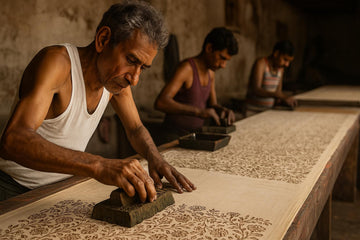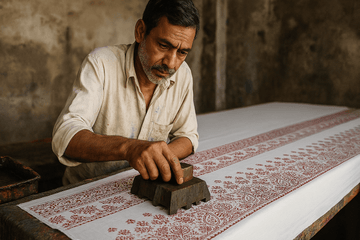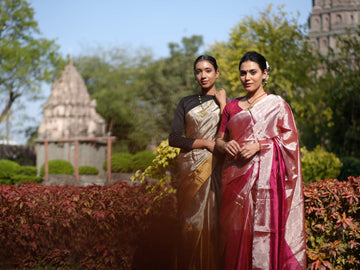
India has a vast variety of handloom weaving crafts and each known for it's destinct designs and textures. Let's take a walk through the 16 major handloom weaving crafts of India, their special features and origin stories.
| No. | Handloom Craft | Region | Origins of the Craft | Special Features | |
|---|---|---|---|---|---|
| 1 | Banarasi Silk | Varanasi, Uttar Pradesh | Banarasi silk sarees have a history dating back to the Mughal era. They are said to have originated in Varanasi, where skilled artisans were patronized by the Mughal emperors. The sarees are known for their rich silk fabric and intricate zari work. | Traditional motifs, intricate patterns, luxurious appeal, Rich silk, intricate zari work | |
| 2 | Kanjeevaram Silk | Kanchipuram, Tamil Nadu | Kanjeevaram sarees have a legendary origin associated with the Hindu mythology. It is said that the silk weavers of Kanchipuram are descendants of Sage Markanda, the master weaver of the Gods. The sarees are characterized by heavy silk, vibrant colors, and zari borders. | Temple borders, checks, contrast pallu. Heavy silk, vibrant colors, zari borders. | |
| 3 | Chanderi | Chanderi, Madhya Pradesh | Chanderi sarees have a royal lineage and are believed to have been woven since the 2nd century. The craft flourished under the patronage of the Scindia rulers. Chanderi sarees are known for their fine silk or cotton fabric, sheer texture, and traditional motifs. | Fine silk or cotton, sheer texture, traditional motifs | |
| 4 | Paithani | Paithan, Maharashtra | The Paithani saree has a history dating back to the 200 BC. It is named after the town of Paithan in Maharashtra. These sarees are known for their peacock and flower motifs, vibrant silk, and elaborate zari borders. | Peacock and flower motifs, vibrant silk | |
| 5 | Patola | Patan, Gujarat | Patola sarees are crafted using a complex double ikat technique. The craft originated in Patan, Gujarat, and has a history dating back over 700 years. Each saree is a result of meticulous craftsmanship, and they feature vibrant geometric patterns. | Vibrant geometric patterns, double ikat technique | |
| 6 | Baluchari | Baluchar, West Bengal | Baluchari sarees have their origins in the Baluchar village of Murshidabad, West Bengal. These sarees gained popularity during the 18th century under the patronage of the Nawab of Bengal. Known for their silk fabric and intricate pallu depicting mythological scenes. | Intricate pallu with mythological scenes | |
| 7 | Assam Silk (Muga) | Assam | Muga silk, used in Assam silk sarees, is exclusive to the region. The Assamese legend believes that the art of silk production was a gift to the people from a celestial nymph. Assam silk sarees are known for their golden luster and traditional designs. | Golden luster, traditional designs. | |
| 8 | Kota Doria | Kota, Rajasthan | Kota Doria sarees originated in Kota, Rajasthan. They are known for their lightweight and transparent texture. The craft has a history dating back to the 17th century and features a square-like pattern. | Lightweight, transparent, square-like patterns | |
| 9 | Pochampally Ikat | Pochampally, Telangana | Pochampally Ikat sarees have their roots in Pochampally village in Telangana. The craft involves resist dyeing the threads before weaving, creating intricate geometric patterns. Pochampally sarees gained recognition as a traditional art form in the mid-20th century. | Ikat weaving, geometric patterns | |
| 10 | Jamdani | West Bengal | Jamdani sarees are known for their sheer muslin fabric and intricate floral motifs. The craft has historical ties to Dhaka (Bangladesh) and was introduced to West Bengal during the Mughal era. Jamdani weaving involves a time-consuming and skilled process. | Intricate floral motifs, sheer muslin | |
| 11 | Maheshwari | Maheshwar, Madhya Pradesh | Maheshwari sarees originated in Maheshwar, Madhya Pradesh, during the 18th century. The craft was patronized by Queen Ahilyabai Holkar. Maheshwari sarees are characterized by silk and cotton blends, vibrant colors, and striped borders. | Vibrant colors, striped borders. Silk and cotton blend. | |
| 12 | Sambalpuri | Sambalpur, Odisha | Sambalpuri sarees have their roots in Sambalpur, Odisha. The craft involves tie-dye and ikat techniques, creating traditional motifs. The weavers of Sambalpur have a rich cultural heritage, and the craft has been passed down through generations. | Ikat and tie-dye techniques, traditional motifs | |
| 13 | Uppada | Uppada, Andhra Pradesh | Uppada sarees originated in the town of Uppada, Andhra Pradesh. They are known for their silk and cotton blends, resembling the jamdani weaving style. The craft gained recognition in the 1980s and is characterized by jamdani-like weaving. | Jamdani-like weaving, silk and cotton blend | |
| 14 | Kantha | West Bengal | Kantha sarees are adorned with hand-embroidered running stitches and originated in the rural households of West Bengal. The craft involves creating intricate patterns and designs through embroidery, making each saree unique. | Hand-embroidered, running stitch on sarees | |
| 15 | Kasavu | Kerala | Kasavu sarees have their origin in Kerala and are an integral part of the state's culture. Typically worn during festivals and weddings, these sarees are made of cotton and feature an off-white base with a gold zari border known as mundum neriyathum. | Simple and elegant - cotton, off-white with gold zari border (mundum neriyathum) | |
| 16 | Tussar | Bihar, & Jharkhand | Tussar silk sarees are crafted from Tussar silk and have their origins in Bhagalpur, Bihar, and Jharkhand. The natural sheen and earthy tones of Tussar silk make these sarees unique, and they have a history dating back centuries. | Natural sheen, earthy tones |
Related Articles





